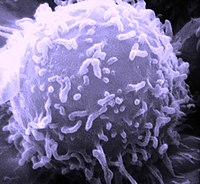
Importance of antibody isotypes in antitumor immunity by monocytes and complement using human‐immune tumor models
Sign Up to like & getrecommendations! Published in 2021 at "European Journal of Immunology"
DOI: 10.1002/eji.202048885
Abstract: Monoclonal antibodies (mAbs) have revolutionized clinical medicine, especially in the field of cancer immunotherapy. The challenge now is to improve the response rates, as immunotherapy still fails for many patients. Strategies to enhance tumor cell… read more here.
Keywords: immune tumor; human immune; importance antibody; immunology ... See more keywords

Dibutyltin‐induced alterations of interleukin 1beta secretion from human immune cells
Sign Up to like & getrecommendations! Published in 2017 at "Journal of Applied Toxicology"
DOI: 10.1002/jat.3339
Abstract: Dibutyltin (DBT) is used to stabilize polyvinyl chloride plastics (including pipes that distribute drinking water) and as a de‐worming agent in poultry. DBT is found in human blood, and DBT exposures alter the secretion of… read more here.
Keywords: dbt; secretion; human immune; secretion human ... See more keywords

Monitoring the Sialome on Human Immune Cells.
Sign Up to like & getrecommendations! Published in 2022 at "Methods in molecular biology"
DOI: 10.1007/978-1-0716-1685-7_17
Abstract: The sialome or display of sialic acids on the surface of human immune cells can vary according to immune response and activation state. Here, human peripheral blood mononuclear cells (PBMCs) were isolated and activated with… read more here.
Keywords: microscopy; chemistry; human immune; monitoring sialome ... See more keywords

The roles for innate lymphoid cells in the human immune system
Sign Up to like & getrecommendations! Published in 2018 at "Seminars in Immunopathology"
DOI: 10.1007/s00281-018-0688-7
Abstract: From constituting a novel and obscure cell population, innate lymphoid cells (ILCs) are now accepted as a self-evident part of the immune system, contributing with unique and complementary functions to immunity by production of effector… read more here.
Keywords: system; innate lymphoid; immune system; human immune ... See more keywords

New approaches to the study of immune responses in humans
Sign Up to like & getrecommendations! Published in 2020 at "Human Genetics"
DOI: 10.1007/s00439-020-02129-3
Abstract: The human immune system consists of multiple, layered mechanisms of sensing and responding to cellular stress, infection and tissue damage to ensure defense from pathogens, maintenance of tissue homeostasis, and the integrity of the holobiont.… read more here.
Keywords: system; new approaches; study immune; immune system ... See more keywords

Inhibitory effect of porphyran on lipopolysaccharide-induced activation of human immune cells.
Sign Up to like & getrecommendations! Published in 2020 at "Carbohydrate polymers"
DOI: 10.1016/j.carbpol.2019.115811
Abstract: In mice, porphyran extracted from Pyropia yezoensis exerts anti-inflammatory effects and suppresses lipopolysaccharide (LPS)-induced immune activation and sepsis. Here, we investigated inhibition of LPS-induced activation of human immune cells by porphyran and the underlying mechanisms.… read more here.
Keywords: lps induced; porphyran; activation human; human immune ... See more keywords

The use of humanized mice for studies of viral pathogenesis and immunity.
Sign Up to like & getrecommendations! Published in 2018 at "Current opinion in virology"
DOI: 10.1016/j.coviro.2018.03.003
Abstract: Humanized mice, that is, animals engrafted with human tissues and/or expressing human genes, have been instrumental in improving our understanding of the pathogenesis and immunological processes that define some of the most challenging human-tropic viruses.… read more here.
Keywords: immune responses; pathogenesis; humanized mice; human immune ... See more keywords

Towards the development of human immune-system-on-a-chip platforms
Sign Up to like & getrecommendations! Published in 2019 at "Drug discovery today"
DOI: 10.1016/j.drudis.2018.10.003
Abstract: Organ-on-a-chip (OoCs) platforms could revolutionize drug discovery and might ultimately become essential tools for precision therapy. Although many single-organ and interconnected systems have been described, the immune system has been comparatively neglected, despite its pervasive… read more here.
Keywords: system; towards development; immune system; human immune ... See more keywords

Making Mouse Models That Reflect Human Immune Responses.
Sign Up to like & getrecommendations! Published in 2017 at "Trends in immunology"
DOI: 10.1016/j.it.2016.12.007
Abstract: Humans are infected with a variety of acute and chronic pathogens over the course of their lives, and pathogen-driven selection has shaped the immune system of humans. The same is likely true for mice. However,… read more here.
Keywords: mouse models; reflect human; human immune; making mouse ... See more keywords

Human immune compartment comparisons: Optimization of proliferative assays for blood and gut T lymphocytes.
Sign Up to like & getrecommendations! Published in 2017 at "Journal of immunological methods"
DOI: 10.1016/j.jim.2017.03.014
Abstract: The accumulation of peripheral blood late-differentiated memory CD8 T cells with features of replicative (cellular) senescence, including inability to proliferate in vitro, has been extensively studied. Importantly, the abundance of these cells is directly correlated… read more here.
Keywords: gut; cd8 cells; blood gut; peripheral blood ... See more keywords

Human immune system adaptations to simulated microgravity revealed by single-cell mass cytometry
Sign Up to like & getrecommendations! Published in 2021 at "Scientific Reports"
DOI: 10.1038/s41598-021-90458-2
Abstract: Exposure to microgravity (µG) during space flights produces a state of immunosuppression, leading to increased viral shedding, which could interfere with long term missions. However, the cellular mechanisms that underlie the immunosuppressive effects of µG… read more here.
Keywords: single cell; mass cytometry; immune system; human immune ... See more keywords